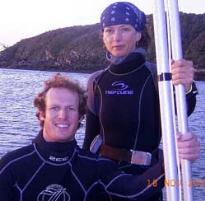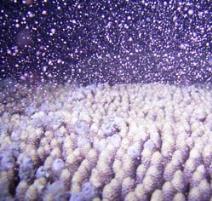Coral spawning observed and documented
Published on 21 November, 2005
For the first time, coral spawning in the Keppel region (an event that takes only a few minutes each year) has been observed and documented.
The Keppel region has some of the best fringing inshore coral reef in the central Great Barrier Reef with over 80% hard coral cover.
Some corals reproduce by producing eggs and sperm in buoyant bundles in a synchronous event once a year shortly after the full moon.
 The mass spawning is timed so that the eggs are fertilized shortly after release and quickly develop into tiny larvae that are carried by currents to settle and develop into juvenile corals.
The mass spawning is timed so that the eggs are fertilized shortly after release and quickly develop into tiny larvae that are carried by currents to settle and develop into juvenile corals.
Coral spawning in the central section of the Great Barrier Reef has been observed and documented at Heron Island for many years but to date, the Keppel region has been somewhat of a mystery.
Shortly after the event a sweet smelling, pink, fatty slick is observed on beaches but is often mistaken for algal bloom.
For the first time, Central Queensland University has observed and documented the yearly event as part of a postgraduate research project in conjunction with the Australian Institute of Marine Science.
Volunteers for the event, Nathan Green and Dave Stewart, with the support of Peter Williams at Keppel Dive, spent hours in the water from dusk to catch the event.
Dave first noticed a pungent smell on the surface and shortly after, Nathan saw the first colony release its tiny pink egg bundles.
Watching such a normally inanimate marine organism suddenly and briefly come to life was an awesome sight.
The spawn is remarkably buoyant and almost in slow motion - masses of pink balls start making their slow way to the surface where they quickly break apart and begin the fertilisation process.
 Volunteers were soon swimming in a sea of coral spawn and after the 15-minute event was over, the surface of the sea was covered in streams of pink eggs. In the light of the underwater torches it was like watching the birth of the stars.
Volunteers were soon swimming in a sea of coral spawn and after the 15-minute event was over, the surface of the sea was covered in streams of pink eggs. In the light of the underwater torches it was like watching the birth of the stars.
CQU would like to thank Peter Williams from Keppel Dive for his dive support, Joanne Pitt from Keppel Haven for accommodating the volunteers, AIMS for the use of their video camera and the Keppel community for their continual support and encouragement of coral research in the Keppels.
For details contact Alison Jones on 4930 9945 or 0408 068 128.
Photos: Researcher Alison Jones with dive volunteer Nathan Green .. and the coral spawning in action.

